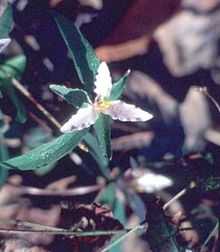Trillium pusillum
| Trillium pusillum | |
|---|---|
 | |
| var. virginianum | |
| Conservation status | |
| Scientific classification | |
| Kingdom: | Plantae |
| (unranked): | Angiosperms |
| (unranked): | Monocots |
| Order: | Liliales |
| Family: | Melanthiaceae |
| Genus: | Trillium |
| Species: | T. pusillum |
| Binomial name | |
| Trillium pusillum Michx. | |
Trillium pusillum is a species of flowering plant in the family Melanthiaceae known by the common names little trillium and dwarf wakerobin. It is native to the southeastern United States as far west as Oklahoma.[1]
This is a perennial herb with a thin, branching, horizontal rhizome. It produces one or two slender scapes up to 20 centimetres (7.9 in) tall. They increase in size after flowering. The three bracts are dark green, sometimes with a red tinge when new. The flower has three green to red-tinged sepals up to 3 centimetres (1.2 in) long and 3 wavy-edged petals which are white and quickly age pink. The 6 stamens are tipped with lavender or yellow anthers each up to a centimeter long. The stigmas have long, narrow, spreading lobes. The pulpy fruit is 1 to 1.5 centimeters long.[2]
The plant can be found in several habitat types, including savannas, swamps, bogs, forests and woods, and fields. It grows on acidic soils.[1] It is commonly pollinated by the western honey bee (Apis mellifera), and the seeds are dispersed by ants and harvestmen.[3]
The species has been divided into several varieties. Some authors accept only two, var. pusillum and var. virginianum.[2] The var. texanum is now treated as a separate species, Trillium texanum.[1]
References
- ↑ 1.0 1.1 1.2 1.3 Trillium pusillum. NatureServe. 2013.
- ↑ 2.0 2.1 Trillium pusillum. Flora of North America.
- ↑ Andre, C. S., et al. (2005). Ecology of three populations of the rare woodland perennial, Trillium pusillum Michaux (Liliaceae) in southwestern Missouri. Missouriensis 26 7-21. (PDF)
| ||||||
